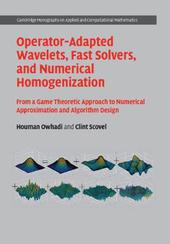
|
Operator-Adapted Wavelets, Fast Solvers, and Numerical Homogenization: From a Game Theoretic Approach to Numerical Approximation
Hardback
Main Details
Description
Although numerical approximation and statistical inference are traditionally covered as entirely separate subjects, they are intimately connected through the common purpose of making estimations with partial information. This book explores these connections from a game and decision theoretic perspective, showing how they constitute a pathway to developing simple and general methods for solving fundamental problems in both areas. It illustrates these interplays by addressing problems related to numerical homogenization, operator adapted wavelets, fast solvers, and Gaussian processes. This perspective reveals much of their essential anatomy and greatly facilitates advances in these areas, thereby appearing to establish a general principle for guiding the process of scientific discovery. This book is designed for graduate students, researchers, and engineers in mathematics, applied mathematics, and computer science, and particularly researchers interested in drawing on and developing this interface between approximation, inference, and learning.
Author Biography
Houman Owhadi is Professor of Applied and Computational Mathematics and Control and Dynamical Systems in the Computing and Mathematical Sciences department at the California Institute of Technology. He is one of the main editors of the Handbook of Uncertainty Quantification (2016). His research interests concern the exploration of interplays between numerical approximation, statistical inference and learning from a game theoretic perspective, especially the facilitation/automation possibilities emerging from these interplays. Clint Scovel is a Research Associate in the Computing and Mathematical Sciences department at the California Institute of Technology, after a twenty-six-year career at Los Alamos National Laboratory, including foundational research in symplectic algorithms and machine learning. He received his Ph.D. in mathematics from the Courant Institute of Mathematics at New York University in 1983. He currently works on uncertainty quantification, Bayesian methods, incorporating computational complexity in Wald's statistical decision theory, operator adapted wavelets and fast solvers.
Reviews'This is a terrific book. A hot new topic, first rate mathematics, real applications. It's an important contribution by marvelous scholars.' Persi Diaconis, Stanford University 'This book does a masterful job of bringing together the two seemingly unrelated fields of numerical approximation and statistical inference to produce a general framework for developing solvers that are both provably accurate and scale to extremely large problem sizes. It seamlessly integrates concepts from numerical approximation, statistical inference, information-based complexity, and game theory to reveal a rich mathematical structure that forms a comprehensive foundation for solver development. Of tremendous value to the practitioner is a thorough analysis of solver accuracy and computational requirements. In addition to providing a comprehensive guide to solver development and analysis this book presents a unique perspective that provides numerous valuable insights into the solution of science and engineering problems.' Don Hush, University of New Mexico 'This unique book provides a novel game-theoretic approach to Probabilistic Scientific Computing by exploring the interplay between numerical approximation and statistical inference, and exploits such links to develop new fast methods for solving partial differential equations. Gamblets are magic basis functions resulting from a clever adversarial zero sum game between two players and can be used in modeling multiscale problems with no scale separation in numerical homogenization. The book provides original exposition to many topics of the modern era of scientific computing, including sparse representation of Gaussian fields, probabilistic interpretation of numerical errors, linear complexity algorithms, and rigorous settings in the Sobolev and Banach spaces of these topics. It is appropriate for graduate-level courses and as a valuable reference for any scientist who is interested in rigorous understanding and use of modern numerical algorithms in problems where data and mathematical models co-exist.' George Karniadakis, Brown University
|